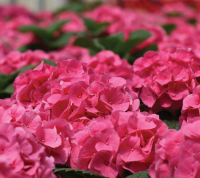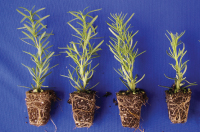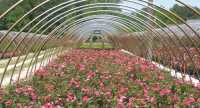PGR’s for Woody Nursery Plants
Do you need to use plant growth regulators (PGRs) in a traditional outdoor nursery?  Let’s go back 10 years when the traditional plants grown in container nurseries were hollies, junipers and other hardwood plants, and the answer would probably be no. PGR use has been an increasing part of the greenhouse industry, primarily aimed at flowering plants.
Let’s go back 10 years when the traditional plants grown in container nurseries were hollies, junipers and other hardwood plants, and the answer would probably be no. PGR use has been an increasing part of the greenhouse industry, primarily aimed at flowering plants.
Fast forward to today and many of the larger container nurseries have moved away from the traditional woody crops and are now focusing on flowering crops. Examples are the explosion of roses, hydrangeas, buddleias, sages and other blooming plants. While many of these are true perennials, they are being grown as annuals in more northern climates for mixed containers, such as dracaena spikes, which were rarely seen outside of tropical areas or interiorscapes. And many of the larger nurseries are now more than 50 percent color crops as opposed to traditional woody plants.
According to Joyce Latimer of Virginia Tech, most of the PGR questions she gets are from nursery operations. She credits this with the expanded production of blooming perennials and especially the use of PGRs on the less herbaceous crops like hydrangeas and roses. Another factor is that the greenhouse grower is more familiar with PGRs and has more established routines or programs.
New market
Many of the current and newly introduced perennials have a lot of color and are changing the marketplace. Most need some sort of help to increase flower production or shorten plants to aid in shipping and handling.

Rosemary plug treated four weeks after Augeo treatment. (L-R) 0 ppm, 400 ppm, 800 ppm, 1,600 ppm. Photo courtesy of Joyce Latimer
Since we don’t want our plants to look like they came from the ditch, we must use measures to improve quality. Growers can either use hand labor to pinch or trim plants, or explore the use of PGRs to increase the quality of their perennial and woody crops. Since quality labor is increasingly expensive, you may very well want to explore the use of PGRs for your crops. Most of the factors involved with these products hold true when used on either herbaceous or woody species, but not always. So seek advice before you begin using them.“I am now growing plants for sale that were weeds in the ditch growing up in southern Missouri,” said Matt Chambers of Stark Bro’s Nurseries in Louisiana, Mo.
A PGR primer
The commercial PGR products fall into six or seven different groups. The main mode of action group is the GA (gibberellic acid) inhibitors. These products inhibit the natural production of GA. All of these products act to hold or reduce internode stretch of plant stems. They can be divided into three basic groups based on their activity or residual action. Group 1 consists of Cycocel and B-Nine—they belong to the ammonium class and are considered as low level of activity.
A-Rest and Topflor belong to the pyrimidine class and are generally considered as medium level of activity.
The highest level of activity and residual action products are members of the triazole class.  Common products are Paczol, Bonzi and Sumagic, and are generally used at very low ppm rates.
Common products are Paczol, Bonzi and Sumagic, and are generally used at very low ppm rates.
The cyclohexaketones are a relatively new class to the ornamental market. Augeo is a new product in this class. The function of Augeo is to trick the plant into thinking it has been pinched to release the lateral shoots. Unlike manual or chemical pinching, Augeo will cause slight yellowing in the apical tips but generally does not abort the tip or flowers. Augeo has been on the market for just a few years and work is very encouraging on perennials.
The third group is the fatty acids such as Off-Shoot O. Their function is to “burn” the tip tissue to perform a classic chemical pinch. Affected tissue generally browns up and then drops off similar to the effect of a manual pruning.
The GA class is generally regarded as growth promoters. The two main products are ProGibb T&O (GA3) and Fascination (a combination of GA 4+7 and benzyladenine). They can be used to correct an overdose of the GA inhibitors or to increase stem elongation where desired.
Ethylene promoters are classified as acids and increase ethylene production in plants. Florel formulations are the main products. They act to disrupt or over-ripen terminal tissues, thus releasing lateral buds. Care must be used if applied too close to flowering, as ethylene can abort flowers.
The rooting hormones are synthetic auxins. Major products are Hormodin and Dip N Grow. Auxins stimulate root production; therefore these products are used for rooting purposes. Herbaceous plants need just a little auxin to promote rooting, while woody plants will require higher levels of auxin to promote rooting.
A new PGR under development is Con-Tego from Valent. It is an abscisic acid (ABA). It is being evaluated for its effect on leaf stomates, the pore cells found on the underside of leaf. By regulating these pores, the plant can withstand dry periods better. Simply stated, the plant needs less water. Commercial interest would be in extending shelf life for plants at the retail level.
While knowledge about using PGRs in nurseries is always expanding, there are numerous university sources of information available to growers including Virginia Tech (http://pubs.ext.vt.edu/430/430-103/430-103_pdf.pdf) and Michigan State http://hrt.msu.edu/floraoe/pgrinfo/).
Paul Pilon offers extensive advice on the culture of perennials including PGRs in his book Perennial Solutions. OHP Inc. (formerly Olympic Horticultural Products) has also made its iPhone PGR calculator app and OHP PGR Solutions available free to growers.
Article by: Andy Seckinger
Tags: Nursery plants, OHP, Paczol, PGR, Plant Growth Regulators
